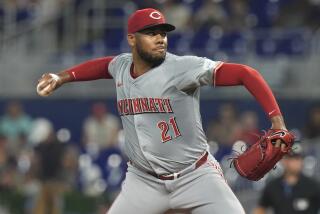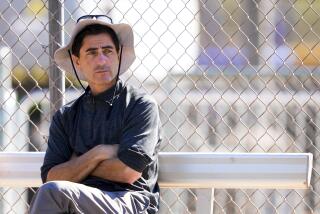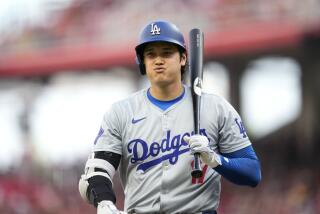Neagle Trade Appears to Have Disarmed Reds
- Share via
They won 96 games last season, traded for Ken Griffey Jr., installed 10 new phone lines to handle the ticket onslaught and now, only a few months later, have virtually given up on the 2000 season by trading the best starting pitcher in a rotation aching for reliable starters but claim they are really building for 2003 when they move into the Great American Ballpark?
“No one wants to lose their No. 1 starter,” Cincinnati Red General Manager Jim Bowden said of the trade that sent Denny Neagle to the New York Yankees for four minor leaguers, “but we have to do the best we can within our market size to put a competitive team on the field. We’re concerned with the reaction, but trading Denny doesn’t mean we don’t want to win between now and [2003].”
It means, Bowden said, that the Reds couldn’t afford to keep their current roster intact because the payroll would jump from about $43 million to more than $70 million.
It also means “we want to stockpile as many good, young players as possible so that by the time we get to the new park, we can be competitive for a long period of time.”
Neagle (8-2) is making $4.75 million this year and is eligible for free agency in October. He recently rejected a three-year, $18-million offer from the Reds, a proposal that paled compared to the four-year, $36-million contract that Brad Radke recently received from the Minnesota Twins.
Neagle’s departure, with the Reds trailing St. Louis in the National League Central by eight games at the time but only 5 1/2 back in the wild-card standings, was compared by some in Cincinnati to the Chicago White Sox’s White Flag swap of July 31, 1997. The Sox, trailing Cleveland by only 3 1/2 games, sent three of their top pitchers to San Francisco for a package of prospects. Two, relievers Keith Foulke and Bob Howry, have become key figures in Chicago’s surprising ascent to the AL Central pinnacle.
If two of the four players sent to the Reds become big league regulars, it will take the sting out of Neagle’s departure, but the success or failure of the transaction may hinge on what Drew Henson decides to do.
A third baseman who was the Yankees’ No. 1 draft choice in 1998, Henson will be the starting quarterback at Michigan this fall, and many in the industry believe the Yankees’ willingness to trade him--he was also included in the aborted deal for Detroit’s Juan Gonzalez--was a tacit admission they think he will opt for football over baseball in the long term.
Henson, in fact, acknowledged on the day after the trade that he now has to rethink his objectives and decide if he has been playing baseball because he loves it or because he was playing for the Yankees.
In the meantime, Cincinnati players bit their tongues and insisted the season isn’t over, although all-star reliever Danny Graves came in through the back door.
“I thought we were trying to win now,” he said. “Maybe we still can. We’re not giving up. If we throw in the towel as a team, what has been a bad enough year already becomes a miserable year.”
Said Barry Larkin: “We were supposed to be undermanned last year and won 96 games. You never know. I mean, the outside perspective is different from what I see as captain. If I see it as doom, it filters down and affects the other players. It’s all about what we think as a team, and what we have to think is we have a chance until mathematically eliminated.”
Of course, Neagle might not be the end of it.
Pete Harnisch, their new No. 1 starter, might also be traded, and the Reds seem to be paving the way for Larkin’s departure, moving triple-A shortstop Gookie Dawkins to second base, which suggests that Pokey Reese will move from second to short, replacing Larkin.
The all-star shortstop is also eligible for free agency and is rumored to have been offered in a package with Neagle to the New York Mets before Neagle was traded to the Yankees. Now, sources have confirmed, the Dodgers are talking to the Reds about Larkin who has trade approval as a 10-and-5 player and whose recent three-year, $28-million contract proposal has yet to draw a Bowden response.
“Trading for me when I’m unsigned doesn’t make sense for other teams, because I’m not a hired gun--not a pitcher or a home run hitter who can win you five games real quick,” Larkin told the Dayton Daily News. “My value is over the long haul. My priority is to stay in Cincinnati, [but] if the Reds don’t want that to happen, it won’t happen.”
Among several players who have been openly critical of Manager Jack McKeon, Larkin added:
“There are a lot of problems underneath the surface here, things that need fixing, but Denny Neagle was not one of them.”
With 30 homers and 76 runs batted in, it would also be hard to portray Griffey as one of the problems. However, his homecoming has not seemed to be the joyous event that was anticipated.
From his recent dugout spat with his father, the Reds’ bench coach, to his private disappointment that the Reds won’t unretire Tony Perez’s No. 24, which he wore in Seattle, to the paradox that is his perceived chagrin at the media attention while complaining of media slights and negativism (“Why do I always come out the villain?” he asked during All-Star interviews in Atlanta), the Griffey persona has become one of baseball’s most perplexing--particularly given his immense and acknowledged talent and that still-boyish enthusiasm at times.
Of course, Griffey’s power is more important to the Reds than his personality, and he can help lessen the loss of Neagle. Whether he can pick up the load if Harnisch and his buddy Larkin are traded is another matter.
More to Read
Go beyond the scoreboard
Get the latest on L.A.'s teams in the daily Sports Report newsletter.
You may occasionally receive promotional content from the Los Angeles Times.










